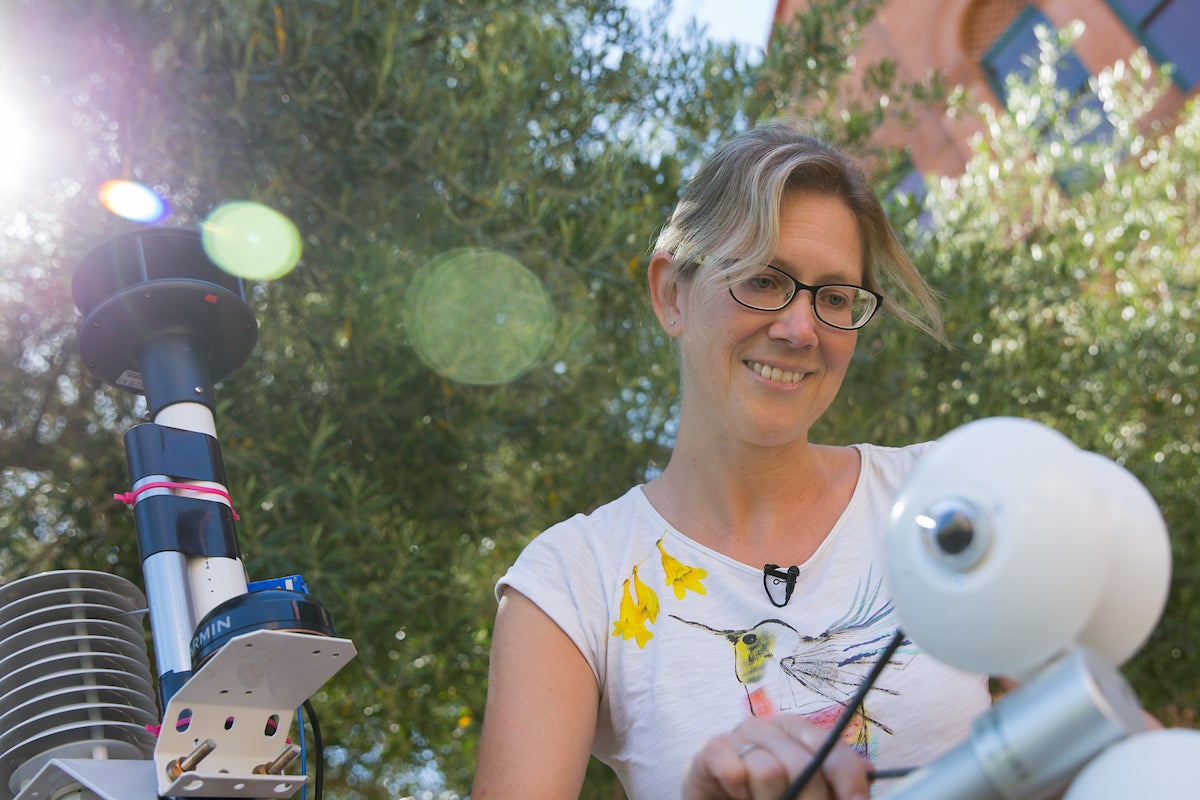As anyone unlucky enough to have spent this summer in the Valley of the Sun knows, it’s been a season of firsts.
The hottest month in Phoenix history. The hottest July. The most nights at lows of 90 degrees. In short, the hottest summer.
And those records will jump this weekend as we look forward to — brace yourself — the hottest Labor Day weekend in Valley history. And all this during a pandemic.
On Sept. 3, Arizona State University hosted a roundtable presentation called “Killer Heat in COVID Times.”
“Phoenix has been breaking any kind of heat record we can think of this year,” said moderator Ariane Middel, who would know.
As a senior sustainability scientist in the university’s Global Institute of Sustainability and Innovation, Middel spends the summer months measuring heat with a robotic instrument suite on wheels.
Ariane Middel, an assistant professor and senior sustainability scientist at ASU, works with her weather robot on the Tempe campus. Photo by Ken Fagan/ASU Now
A key aspect to surviving the summer is how people are exposed to the heat, Middel said. Changing materials and providing more shade can help. She discussed a number of projects being carried out by the university’s Healthy Urban Environment initiative.
A city of Tempe project — Right Shade in the Right Place — took a look at issues facing municipal efforts to cool public space.
Cities face challenges in placing trees because of utility lines overhead and underground.
Preliminary results show shade from urban forms — such as buildings and walkways — are most effective. Trees are second best. Engineered shade, like awnings over playgrounds and picnic areas, comes in third, although “any shade is good,” Middel said.
The Phoenix Zoo wants to expand its parking lot. Middel took her mobile weather cart to the zoo this summer to take readings. Zoo officials want to place shade structures around the south and east end of the lot to cover people walking to the zoo entrance.
The city of Phoenix has applied CoolSeal, a coating that reflects heat back into the atmosphere instead of storing it in the pavement, in eight neighborhoods. The project is being measured this year and next to assess its effectiveness.
Mark Hartman is a chief sustainability officer with the city of Phoenix. His job involves working with ASU to mitigate extreme heat.
Phoenix is hotter than rural areas by 21 degrees, Hartman said. Urban heat affects public health, vulnerable populations and economic viability.
Living in a desert is “part of our DNA,” Hartman said. “How do we make the place cool for people dependent on transit?”
Phoenix has implemented a number of measures to battle summer scorching, among them a walkable urban code. It designates 70% of areas around buildings need to be shaded.
The city also is studying cool coatings, cool materials and cool corridors (a tree and shade master plan), Hartman said.
To help the most vulnerable during hot days, the city is putting a few hundred people a day into cooling centers like the convention center.
Masavi Parea is the coalitions and trainings director for CHISPA Arizona, an organization focusing on environmental justice for the Hispanic community.
“We know this heat is not normal,” Parea said. “We walk to schools. We walk to work. … We as a community have to engage. … We have to stop this reality.”
The discussion was part of the Global Institute of Sustainability and Innovation’s Case Critical series, which responds to time-sensitive sustainability concerns at the local, national and global levels. It was co-hosted by ASU's Healthy Urban Environment initiative.
Top image by Gerhard G., courtesy of Pixabay.
More Health and medicine

What makes human culture unique?
Why is human culture — the shared body of knowledge passed down across generations — so much more powerful than animal cultures?“What’s special about our species?” is a question scientists have…

ASU honors students work on HPV research as part of Barrett College's largest-ever group thesis
Not every undergraduate student comes across the opportunity to do research as part of a team. Even fewer have had the chance to join a team of 86 students doing multidisciplinary research with real-…

College of Health Solutions alumnus named Military Medic of the Year
By Keri Hensley and Kimberly LinnJonathan Lu has looked out for the health of his fellow military service members his whole career, starting with his role as a combat medic in the U.S. Army.Driven by…

